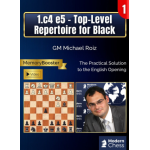1.c4 e5 – Top-Level Repertoire for Black – Part 1 Modern Chess
Original price was: $ 100.$ 3Current price is: $ 3.
OFF - 97%10000 in stock

Description
Reviews (0)
Description
| Category | PREMIUM CHESS VIDEO, MODERN CHESS |
|---|
We are happy to announce another fascinating project by GM Michael Roiz – 1.c4 e5 – Top-Level Repertoire for Black – Part 1. In this two-part series, GM Roiz will provide you with a practical and very strong repertoire against the English Opening. The current database is covering the position arising after 1.c4 e5 2.Nc3 Bb4. The second part will deal with all White’s alternatives to 2.Nc3.
As usual, Roiz provides many new ideas in theoretically important positions. Besides, all the variations are based on very solid strategic foundations.
The course consists of 14 theoretical chapters, 14 interactive test positions, a Memory Booster, and a Video Version (2h and 22min).
Let’s take a look at the initial position arising after 1.c4 e5 2.Nc3 Bb4

Practically speaking, the move 2…Bb4 is the easiest weapon against White’s setup. In this line, Black often can handle the arising positions by relying on the understanding of the pawn structures. Basically, we play Rossolimo with colours reversed. If you want to further improve your understanding of these positions, you can also take a look at the following two databases in which Roiz examines the Rossolimo from White’s perspective.
1) Play the Rossolimo – Top-Level Repertoire for White – Part 1
2) Play the Rossolimo – Top-Level Repertoire for White – Part 2
The first five chapters revolve around the continuations that allow Black to double White’s pawns by means of …Bxc3. Chapters 1-2 deal with 3.g3 while the moves 3.e3 and 3.Nf3 are covered in Chapters 3-5. In all these lines, we immediately take on c3. Later on, what matters is your understanding of the pawn structure. In such positions, you can easily outplay your opponent, provided that you have a better understanding.
Chapter 6 deals with the continuation 3.Qc2.

This move is currently White’s second choice after 2.Nd5. White avoids the damage of the pawn structure and intends to acquire the bishop pair after forcing an exchange with ..a2-a3.
Our response is 3…d6. This flexible move is relatively rare. Black strengthens e5 and makes the retreat of Bb4 possible in the long run. Also, in some cases, Black can afford to concessing his bishop, even without waiting until White plays a2-a3.
The move 3.Qb3 is examined in Chapter 7.

In analogy to 3.Qc2, White is interested in maintaining the flexibility of his pawn structure in the case of Bxc3. Black’s bishop is attacked, but b3-queen is placed awkwardly. In this case, we play 3…a5. A flexible move. Black defends the pawn and keeps the c-pawn unblocked, which is the opposite of the most common 3…Nc6. Quite often, Black doesn’t mind capturing on c3, especially in the case of a2-a3.
From Chapter 8, Roiz starts examining the main line beginning with 3.Nd5. In this case, he suggests the retreat 3…Be7.

In this position, White has two main continuations – 4.Nf3 and 4.d4.
Chapters 8-10 are dedicated to 4.Nf3. Our response would be 4…d6. In this position, Roiz covers all possible continuations and move orders. Now, we will only mention that the main line goes 5.d4 Nf6

Black responds with an interesting pawn sacrifice. By developing the knight Black also takes control of key e4-square. In the arising complex positions, Black has an excellent counterplay.
The move 4.d4 is the subject of Chapters 11-13. The absolute main line after 4.d4 goes 4…exd4 5.Qxd4 Nf6 6.Nxe7 Qxe7 7.Bg5 Nc6 8.Qc3 d6 9.Bxf6 Qxf6 10.Qxf6 gxf6 11.e3 Be6

Statically, White’s position is preferable. However, Black has a definite development advantage, that may tell if the position opens up.
Of course, Roiz also covers all White’s deviations from the main line.
Chapter 14 is dedicated to all White’s rare options on move 3. Even though these moves are not objectively dangerous, you should be familiar with the arising positions.
Reviews (0)
Leave a Reply











Reviews
There are no reviews yet.